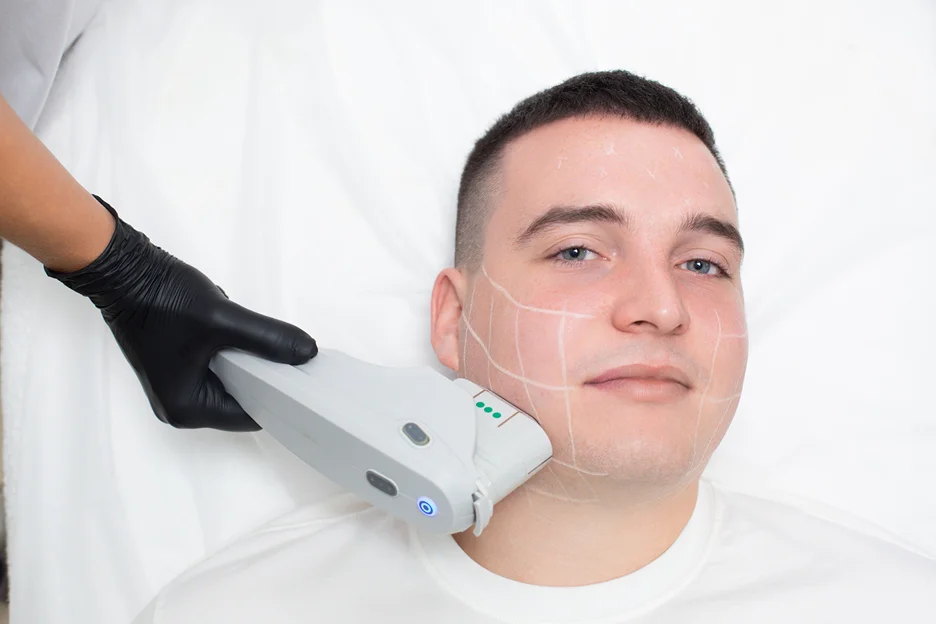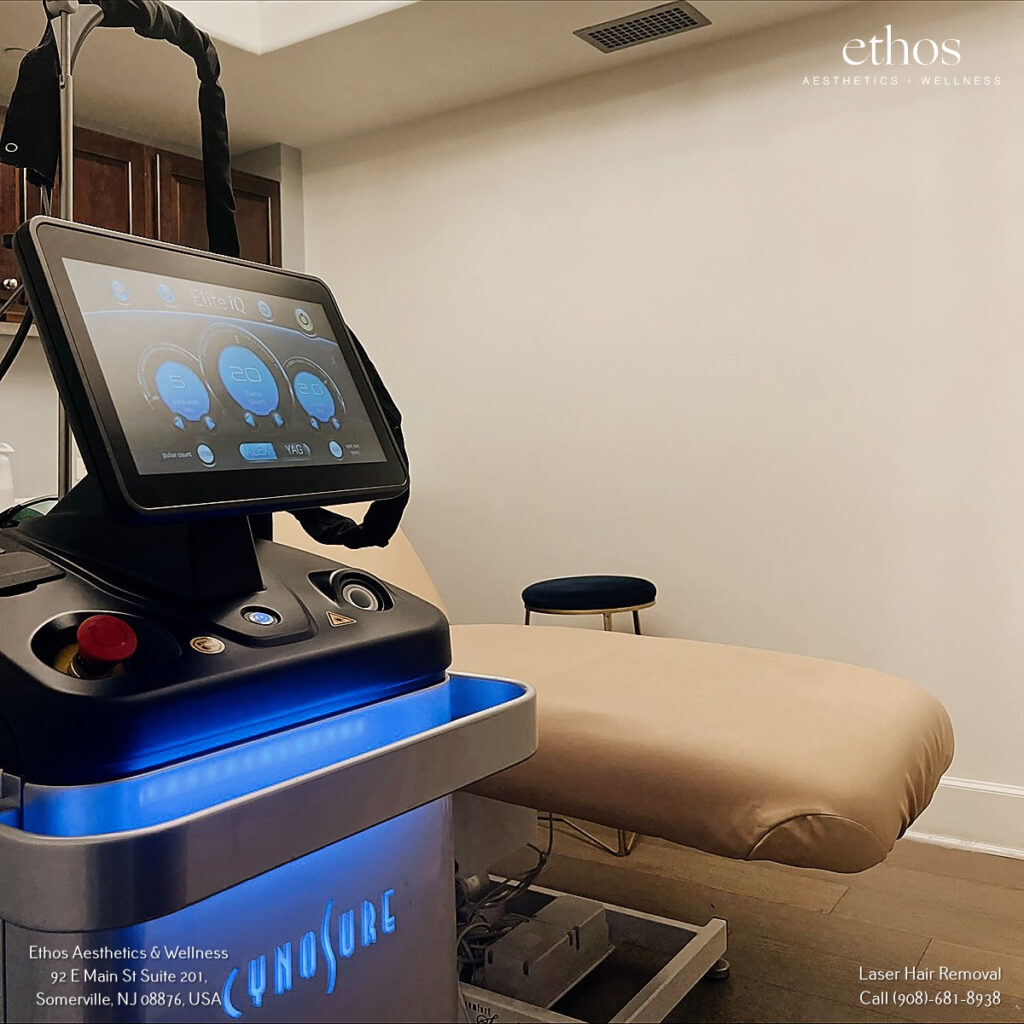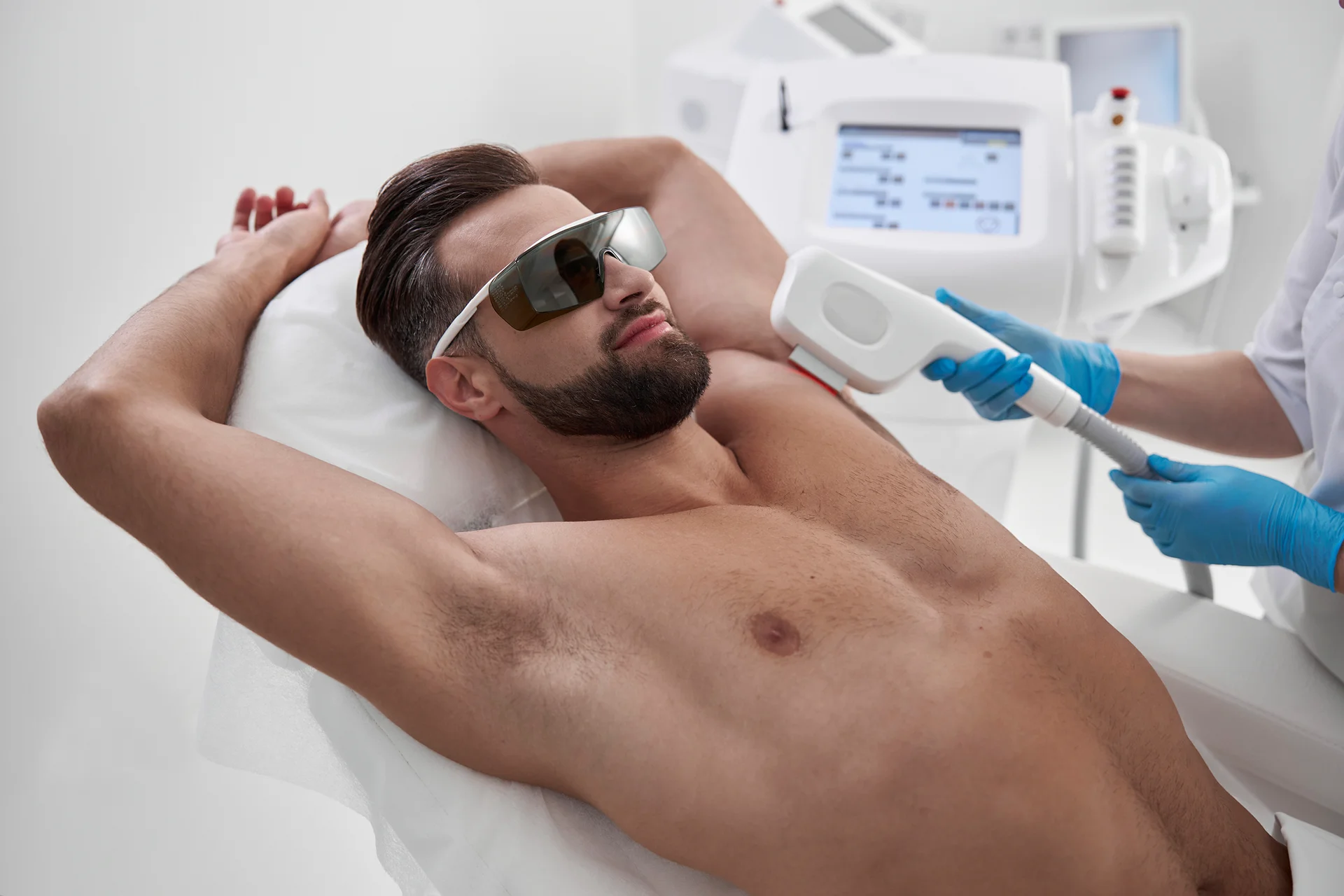Benefits, Process, and Expert Tips
Shaving regularly can be a real pain—literally. Razor burn, ingrown hairs, and constant stubble are just some of the hassles men face while trying to maintain smooth skin.
But what if there was a long-term solution for eliminating unwanted body and facial hair?
Laser hair removal offers men the chance to kiss rough shaves goodbye.
Dr. Hardik Soni, founder of Ethos Aesthetics & Wellness, provides his expert insights on the process, safety, and advantages of this popular treatment for male clients.
What Are the Benefits of Laser Hair Removal for Men?

For males struggling with chronic irritation from shaving, laser hair removal can provide the relief and results they’ve been looking for. Some of the key benefits include:
- Improved hygiene and reduced odor by removing hair from sweat-prone areas like the underarms.
- A permanent reduction in hair growth leads to smooth skin that endures. Dr. Soni observes that the majority of clients experience a significant and lasting decrease in hair growth following the completion of their treatment plan.
- Elimination of ingrown hairs and razor bumps caused by shaving. This removes unsightly blemishes and uncomfortable inflammation.
- Soft, stubble-free skin that feels and looks great every day, without the hassle of daily shaving sessions.
- Increased confidence from having clean, attractive-looking skin, free of shaving rashes or five o’clock shadows.
How Does Laser Hair Removal Work and Is It Safe for All Skin Types?
During a laser hair removal session, a handheld device emits a concentrated beam of light that targets and damages the pigment in hair follicles. This impairs their ability to regrow, causing permanent hair loss over the course of treatments.
Dr. Soni explains that laser technology allows practitioners to customize settings based on a client’s unique hair and skin type.
Parameters like wavelength, pulse duration, and energy levels can be adjusted to safely remove hair while protecting the surrounding skin.
Advanced devices today make laser hair removal accessible for all skin tones. However, those with darker skin should consult a specialist beforehand to prevent burns. When used correctly, lasers are effective for every skin type.
What Should Men Expect During Their First Laser Hair Removal Session?
Preparing for a laser session is simple. Dr. Soni suggests arriving with freshly shaved skin to allow the laser optimal access to each follicle. No other pre-treatment steps are required.
The first session involves mapping out the treatment areas and determining ideal laser parameters.
While mapping may take 15-30 minutes, the actual laser pulses only last a split second as they target each hair follicle. Men may experience a slight pricking sensation with each pulse.
Once complete, the treated area is soothed with a cooling gel or spray. Use of cold compresses and aloe vera gels at home can provide further relief if any redness or swelling occurs post-treatment. Always consult your clinician on proper aftercare.
Overall the process is quick, easy, and well-tolerated. With no downtime required, men can immediately return to their daily routines after each session.
How Many Sessions Are Typically Needed for Effective Results?
Most men require an average of 6 sessions spaced 4-6 weeks apart to achieve desired hair removal. However, Dr. Soni notes 10 or more sessions may be recommended for thick coarse hair in larger treatment areas.
Spacing sessions allow hair to reenter its growth cycle so remaining follicles can be effectively targeted at the next appointment. During this period, patients will notice the shedding of treated hairs.
Progress is assessed at follow-ups to determine if additional sessions are warranted based on the individual response. Maintenance sessions may also be suggested annually to catch stray regrowth.
Laser Precision for the Distinguished Man: Ethos Aesthetics & Wellness’s Hair Removal Services
Can Men Undergo Laser Hair Removal for Facial Hair?
One of the most popular applications of laser hair removal among male clients is eliminating facial hair for smooth, stubble-free skin.
Dr. Soni notes that the procedure can effectively reduce hair on the cheeks, neck, upper lip, chin, sideburns, and other facial regions.
However, denser areas like beards and mustaches may require more intensive laser settings and additional sessions to achieve the desired results.
During the procedure, special care is taken when treating sensitive areas near the lips and eyes, with protective eyewear being a standard precaution. Dr. Soni advises against laser treatment in the presence of cold sores, as the heat can worsen them.
Lasers offer a long-term solution to daily shaving woes and are particularly beneficial for men suffering from pseudo-folliculitis barbae (PFB), as it helps prevent the occurrence of ingrown hairs.
How Does Laser Hair Technology Differ for Men’s Coarser Hair?
Male body and facial hair tend to be coarser and thicker than female hair. To tackle this robust growth effectively, Dr. Soni tailors the treatment approach.
Higher laser energy outputs and heat settings are utilized to penetrate beneath the surface and disable deep, resilient hair follicles.
More sessions are also often required to fully clear masculine hair on larger body zones.
Additionally, Dr. Soni may use diode or Nd:YAG laser technology for darker male complexions to minimize any risk of burns before switching to more aggressive devices.
This step-up approach safely removes coarse hairs across all skin tones.
Are There Areas Men Should Avoid Treating with Laser?
While laser hair removal is very safe when performed properly, Dr. Soni suggests certain male regions may be better suited to other treatments:
- Moles or Skin Lesions: To prevent irritation and potential scarring, moles and skin lesions should be avoided during laser treatment.
- Bony Areas: The effectiveness of laser hair removal decreases on uneven surfaces such as the spine or joints, where it is more challenging to target hair follicles accurately.
- Scrotum and Testicles: The scrotum’s delicate skin is susceptible to heat damage. Alternative methods like waxing or depilatory creams may be safer for this sensitive area.
- Penile Shaft: For the genital area or penile shaft, lasers require extreme precision to avoid burns. Procedures in these regions should only be conducted by highly specialized professionals. Alternative hair removal methods are recommended.
- Infected Skin: Avoid laser treatment on areas with bacterial or viral infections, including cold sores, to prevent exacerbating the condition or spreading the infection.
Careful treatment planning and practitioner experience ensures lasers are only used on suitable male body areas and facial regions for optimal safety.
How Cost-Effective Is Laser Hair Removal in the Long Run?
Laser hair removal can be cost-effective over time. Dr. Soni points out that despite the initial cost for multiple sessions, it proves economical when measured against the ongoing expense of razors, creams, and waxing. Clients also benefit from time saved on daily grooming.
The lasting smoothness and infrequent need for touch-ups add to its value, making it an investment with enduring benefits. With various pricing and financing options available, it offers sustainable value.
What Results Can Men Expect from Laser Hair Removal Treatments?
Men can expect a substantial reduction in hair growth after completing a series of laser hair removal treatments, as noted by Dr. Soni.
While not all hair follicles may be permanently removed, the majority of men experience 70-90% less hair in the treated areas, leading to smoother skin without the stubble or ingrown hairs often caused by shaving.
Although some finer hairs might persist, they can be easily handled with occasional touch-up sessions. The enduring results typically offer a more permanent solution than conventional methods like shaving.
What Areas of the Body Do Men Commonly Have Treated?
Men often choose laser hair removal for various body areas to attain smooth, hair-free skin. Popular treatment areas include:
- Back: To eliminate thick hair and provide a neater appearance.
- Shoulders and Upper Arms: For a more defined look, especially when wearing sleeveless clothing.
- Chest and Abdomen: To sculpt a cleaner, manscaped torso.
- Bikini Line: For a well-groomed look around swimwear.
- Legs: Making shorts more comfortable to wear.
- Neck: To maintain a sharp hairline free from stray neck hairs.
Men also frequently opt to treat the underarms, hands, and feet. Dr. Soni tailors treatment plans to meet individual aesthetic goals, ensuring personalized care.
What Physical Factors Influence Laser Hair Removal Effectiveness?
Several physical characteristics can affect the effectiveness of laser hair removal for men, such as:
- Hair color: Lasers target melanin pigment, so gray, blonde, or red hairs are harder to treat. Dark brown or black hair shows the best response.
- Hair thickness: Coarse thick hairs are disabled more effectively than fine thin hairs by laser heat.
- Skin tone: Pale skin presents no barrier for targeting hairs, while darker pigment requires lower, safer settings.
- Hair growth cycles: Hair needs to be in its active growing phase to be affected, making treatment timing important.
- Hormones: Higher testosterone and DHT in men boosts hair growth. This may require more sessions for long-term reductions.
- Genetics: Some inherited factors lead to faster hair regrowth between sessions. Family history should be considered.
Dr. Soni analyzes these traits during consultations to set accurate expectations for success. While results vary, most men achieve their goals through personalized plans.
What Are the Potential Side Effects or Risks?
When performed correctly by a trained professional, laser hair removal is a very safe procedure. However, Dr. Soni advises male patients of a few potential side effects including:
- Skin Redness, Swelling, and Sensitivity: These are common and generally short-lived, subsiding within a few hours to a few days.
- Minor Blistering or Crusting: This can occur but usually heals quickly with correct care.
- Bruising or Discoloration: More likely on sensitive facial skin, this typically diminishes within a week or two.
- Ingrown Hairs: These may appear as the hair sheds post-treatment but are usually temporary. Regular exfoliation can help prevent them.
- Scarring: Very rare when proper laser settings are used; darker skin tones have a higher risk if not carefully treated.
Dr. Soni emphasizes these effects are temporary and can be minimized with experienced clinicians using proper post-care. When performed correctly, laser hair removal enables safe, smooth, stubble-free skin.
Frequently Asked Questions About Laser Hair Removal for Men
Will Laser Hair Removal Cause My Hair to Grow Back Thicker or Darker?
No, laser hair removal doesn’t cause hair to grow back thicker or darker. Post-treatment, the hair may feel coarser due to the treated end, but this is temporary.
Is Laser Hair Removal Effective on Facial Hair?
Yes, laser hair removal can significantly reduce unwanted facial hair. Multiple sessions are required for lasting results, and a professional consultation is advised to assess suitability.
What Is the Expected Timeline for Seeing Results on Body Hair?
A noticeable reduction in body hair typically occurs after 3-6 sessions, spaced 4-6 weeks apart. Optimal results often require 6-8 treatments, with the best response seen in dark hair against lighter skin.
Can I Have Laser Hair Removal Done During Summer?
Laser hair removal can be performed in summer, but sun exposure should be minimized before and after sessions. Protecting the skin with a minimum SPF 30 sunscreen for 4-6 weeks post-treatment is crucial.
Is Laser Hair Removal Safe While on Medication?
Certain medications, like isotretinoin or antibiotics, increase skin sensitivity to lasers. Consult your dermatologist about any medications before starting laser hair removal.
How Long Do Laser Hair Removal Results Last?
Results can last 1-3 years after a series of treatments. Periodic touch-ups every 6-12 months can maintain results, but permanent hair removal isn’t guaranteed due to potential hormonal changes or other factors affecting hair growth.
Redefining Men’s Grooming: Dr. Soni’s Approach to Laser Hair Removal

Start your journey to hassle-free skin with Dr. Hardik Soni at Ethos Aesthetics & Wellness. If you’re considering laser hair removal but don’t know where to begin, trust us to guide you through the process with expertise and care. Contact us today or book your consultation online to take the first step towards a confident, hair-free you.







